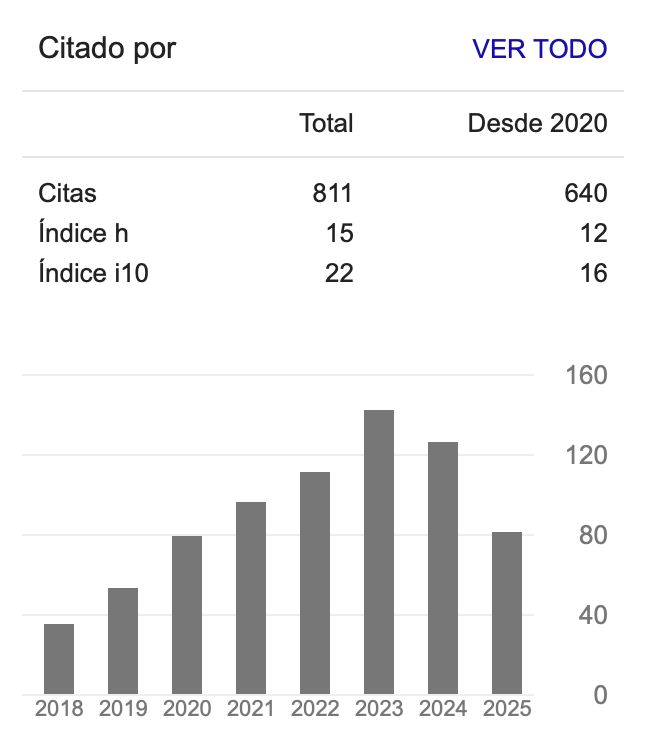Comparative by Gender in the Relationship of Learning Styles and Volitional Strategies
Comparativo en función del género en la relación de estilos de aprendizaje y estrategias volitivas
DOI:
https://doi.org/10.54104/papeles.v15n30.1518Keywords:
Learning method, affectivity, motivation, volition, university studentAbstract
Introduction: YouTube is a huge catalog of videos on various topics, and it is a precept to come to this social network to see tutorials and answer questions regarding a specific topic. The eduyoutubers facilitate the work as educational edutubers, but to be precise and rigorous in the selection of these, it is necessary to have resources and tools that allow us to evaluate them, under pedagogical criteria. This study presents as the main objective of the research, it defines a selection process that will determine a catalog of pedagogical and didactic videos of mathematics, for the secondary educational level in Italy, and in relation to those videos most used by the students. Methodology: A total of 4845 students, between the ages of 13 and 22 living in Italy, were asked which edutuber and/or YouTube channels they use to support mathematical learning, then five videos were analyzed and the aspects to be evaluated were identified in relation to the following criteria: curricular; technical, aesthetic and expressive; pedagogical; didactic mathematics; and accessibility. As an instrument for data and information collection, a questionnaire was acquired that was validated through expert judgment, Cronbach’s Alpha. Results and discussion: The results mainly show that the students use the YouTube social network, as the main resource for consultation and help, to understand mathematics at secondary educational levels, noting that there is no specific profile for the use of this social network. Conclusions: it is concluded that the clarity of the content presented is important for the students, but it is important above all how it is presented, when distinguishing the two channels that, given the parity of well-presented content, attend to and take care of the technical, aesthetic and expressive aspects.
Downloads
References
Aguilar-Barojas, S. (2005). Fórmulas para el cálculo de la muestra en investigaciones de salud. Salud en Tabasco, 11(1-2), 333-338. https://biblat.unam.mx/hevila/SaludenTabasco/2005/vol11/no1-2/5.pdf
Aguilera Pupo, E. y Ortiz Torres, E. (2010). La caracterización de perfiles de estilos de aprendizaje en la educación superior: Una visión integradora. Revista Estilos de Aprendizaje, 3(5), 26-41. https://doi.org/10.55777/rea.v3i5.900
Al-Mulhim, E. N. (2021). Flipped learning, self-regulated learning and learning retention of students with internal/external locus of control. International Journal of Instruction, 14(1), 827-846. https://doi.org/10.29333/iji.2021.14150a
Alonso, C. M., Gallego, D. J. y Honey, P. (1997). Los estilos de aprendizaje: Procedimientos de diagnóstico y mejora (7.ª ed.). Mensajero.
Arias Barahona, R. y Aparicio, A. S. (2020). Conciencia metacognitiva en ingresantes universitarios de Ingeniería, Arquitectura y Ciencias Aeronáuticas. Propósitos y Representaciones, 8(1), e272. https://doi.org/10.20511/pyr2020.v8n1.272
Baltaci, S., Yildiz, A. & Özcakir, B. (2016). The relationship between metacognitive awareness levels, learning styles, genders and mathematics grades of fifth graders. Journal of Education and Learning, 5(4), 78-89. http://dx.doi.org/10.5539/jel.v5n4p78
Baltaoğlu, M. G. & Güven, M. (2019). Relationship between self-efficacy, learning strategies, and learning styles of teacher candidates (Anadolu University example). South African Journal of Education, 39(2), 1-10. https://doi.org/10.15700/saje.v39n2a1579
Biabani, M. & Izadpanah, S. (2019). The study of relationship between kolb’s learning styles, gender and learning american slang by iranian EFL students. International Journal of Instruction, 12(2), 517-538. https://doi.org/10.29333/iji.2019.12233a
Çakiroğlu, Ü., Er, B., Uğur, N. & Aydoğdu, E. (2018). Exploring the use of self-regulation strategies in programming with regard to learning styles. International Journal of Computer Science Education in Schools, 2(2), 14-28. https://doi.org/10.21585/ijcses.v2i2.29
Corno, L. (1993). The best-laid plans: Modern conceptions of volition and educational research. Educational Research Association, 22(2), 14-22. https://doi.org/10.2307/1176169
Corno, L. (2004). Introduction to the special issue work habits and work styles volition in education. Teachers College Record, 106(9), 1669-1694. https://doi.org/10.1111/j.1467-9620.2004.00400.x
Flores Alanís, A. A., Rodríguez Hernández, J. M. y Chávez González, G. (2019). La transformación de la educación básica en México desde la perspectiva de la educación 4.0. En S. Pérez-Aldeguer y D. O. Acombo (eds.), Research, technology and best practices in education (pp. 103-111). Adaya Press.
Gaeta González, M. L. (2009). La autorregulación del aprendizaje: La estructura del aula, la orientación a metas y las estrategias volitivas y metacognitivas en escolares adolescentes. Revista Electrónica Interuniversitaria de Formación del Profesorado, 12(2), 157. https://www.redalyc.org/pdf/2170/217015206012.pdf
Gamba, S. B. (2007). Diccionario de estudios de género y feminismos. Biblos.
Girón-García, C. & Gargallo-Camarillas, N. (2020). Multimodal and perceptual learning styles: Their effect on students’ motivation in a digital environment. The EuroCALL Review, 28(2), 23-38. https://doi.org/10.4995/eurocall.2020.12758
Honey, P., & Mumford, A. (2000). The learning styles helper's guide. Maidenhead: Peter Honey Publications.
Juárez Lugo, C. S. (2014). Propiedades psicométricas del cuestionario Honey-Alonso de estilos de aprendizaje (CHAEA) en una muestra mexicana. Journal of Learning Styles, 7(13). https://doi.org/10.55777/rea.v7i13.1011
Landero Hernández, R. y González Ramírez, M. T. (2006). Estadística con SPSS y metodología de la investigación. Trillas.
Larruzea-Urkixo, N. y Cardeñoso-Ramírez, O. (2020). Diferencias individuales en aprendizaje autorregulado de estudiantes de los grados de Educación: Género, especialidad, notas y desempeño académico. Revista de Investigación Educativa, 38(2), 453-473. https://doi.org/10.6018/rie.334301
Lozano Rodríguez, A. (2006). Estilos de aprendizaje y enseñanza: Un panorama de la estilística educativa. Trillas.
Martínez Vicente, M. y Valiente Barroso, C. (2019). Autorregulación afectivo-motivacional, resolución de problemas y rendimiento matemático en educación primaria. Educatio Siglo XXI, 37(3), 33-54. https://doi.org/10.6018/educatio.399151
Mašić, A., Polz, E. & Bećirović, S. (2020). The relationship between learning styles, GPA, school level and gender. European Researcher, 11(1), 51-60. https://doi.org/10.13187/er.2020.1.51
McCann, E. J. & García, T. (1999). Maintaining motivation and regulating emotion: Measuring individual differences in academic volitional strategies. Learning and Individual Differences, 11(3), 259-279. https://doi.org/10.1016/S1041-6080(99)80003-X
McCann, E. J. & Turner, J. E. (2004). Increasing student learning through volitional control. Teachers College Record, 106(9), 1695-1714. https://doi.org/10.1111/j.1467-9620.2004.00401.x
Navarro Saldaña, G., Flores-Oyarzo, G. y González Navarro, M. G. (2019). Diferencias por sexo en el nivel de autoeficacia percibida en una muestra de estudiantes de la provincia de Concepción: ¿Qué papel juegan los roles de género en la educación? Revista de Educación Inclusiva, 12(1), 205-2234. https://revistaeducacioninclusiva.es/index.php/REI/article/view/389/374
Ortiz Elizalde, B. (2022). ¿Lo mismo para todos? El currículo graduado de saturación de contenidos en las aulas de educación primaria. Educación en Movimiento, 1(1), 11-17. https://www.mejoredu.gob.mx/images/publicaciones/boletin-3/Boletin-1-2022.pdf
Otzen, T. y Manterola, C. (2017). Técnicas de muestreo sobre una población a estudio. International Journal of Morphology, 35(1), 227-232. http://dx.doi.org/10.4067/S0717-95022017000100037
Özaydin Özkara, B. & Ibili, E. (2021). Analysis of students’ e-learning styles and their attitudes and self-efficacy perceptions towards distance education. International Journal of Technology in Education and Science, 5(4), 550-570. https://doi.org/10.46328/ijtes.200
Palomé-Vega, G., Escudero-Nahón, A. y Juárez Lira, A. (2020). Impacto de una estrategia b-learning en las competencias digitales y estilos de aprendizaje de estudiantes de enfermería. RIDE: Revista Iberoamericana para la Investigación y el Desarrollo Educativo, 11(21). https://doi.org/10.23913/ride.v11i21.726
Payaprom, S. & Payaprom, Y. (2020). Identifying learning styles of language learners: A useful step in moving towards the learner-centred approach. Journal of Language and Linguistic Studies, 16(1), 59-72. https://doi.org/10.17263/jlls.712646
Ruland Marantika, J. E. (2022). The relationship between learning styles, gender and learning outcomes. Kıbrıslı Eğitim Bilimleri Dergisi, 17(1), 56-67. https://doi.org/10.18844/cjes.v17i1.6681
Silva-Ramos, M. F., López-Cocotle, J. J. y Meza-Zamora, M. E. C. (2020). Estrés académico en estudiantes universitarios. Investigación y Ciencia de la Universidad Autónoma de Aguascalientes, 28(79), 75-83. https://doi.org/10.33064/iycuaa2020792960
Toribio-Ferrer, C. y Franco-Bárcenas, S. (2016). Estrés académico: El enemigo silencioso del estudiante. Revista Salud y Administración, 3(7), 11-18. https://botica.xyz/estres-academico/
Trejo Sirvent, M. L., Llaven Coutiño, G. y Pérez y Pérez, H. C. (2015). El enfoque de género en la educación. Atenas, 4(32), 49-61. https://www.redalyc.org/comocitar.oa?id=478047208004
Velasco Angulo, C. y Cardeñoso Ramírez, O. (2020). Evaluación de la competencia de aprendizaje autorregulado en función del nivel educativo. Perfiles Educativos, 42(169), 8-20. https://doi.org/10.22201/iisue.24486167e.2020.169.58687
Downloads
Published
-
Abstract513
-
PDF (Español)164
How to Cite
Issue
Section
Categories
License
Copyright (c) 2023 María del Socorro Rodríguez Guardado, Catalina Juárez Díaz

This work is licensed under a Creative Commons Attribution-NoDerivatives 4.0 International License.






